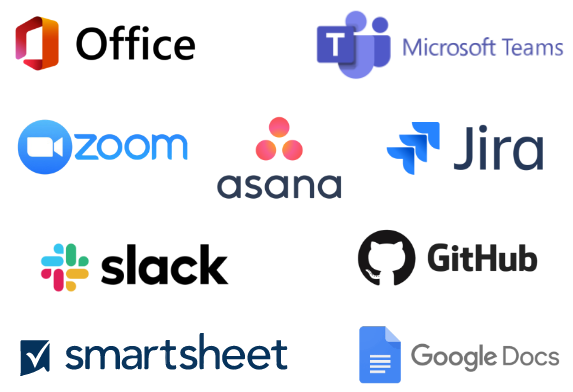10 Steps to Succeed At Your First Consulting Project (Guide)

Once you secure your first consulting project, there are a few things to consider to ensure your success. This guide will walk you through how to execute your project successfully, collaborate effectively with your client, and build a strong relationship that positions you for future business opportunities.
GATE
What to Do After You Win Your First Project
After you win your first project, you may be asking yourself a couple of key questions, such as:
Where will I work? As an independent consultant, you generally have the freedom to choose your work location. Whether working from home or sharing space in a co-working facility, make sure you are set up for success.
What resources do I need? Ensure that you have the necessary office equipment and supplies, including any specialized equipment or software, to support your client engagement. Consider the day-to-day project work as well as the administrative details.
Below, we’ll review the key decisions you must make to get off to a successful start:
Setting up your home office
Below are a few must-have items for setting up your home office:
- Phone system. Systems such as RingCentral, eVoice, and Google Voice allow you to have a central phone number, which can be routed to designated phones, eliminating the need for a separate business line. Many of America’s independent professionals are running their business physically alongside many others in a shared space. For many, co-working is a desirable option.
- Computer. You can choose a desktop or a laptop, depending on your preference. But consider that a laptop may be useful when you want to work somewhere other than your main office. A Mac or PC is fine—just make sure it fits the type of work you’re doing and your budget!
- Internet connection. Internet service is a tax-deductible expense, so consider investing in a premium plan for improved download speed and an optimal experience when sharing files or video chatting.
- Fax capability. You can skip the standard fax machine and use services such as eFax which will enable you to send and receive documents from any device.
- Cloud storage. A cloud storage system such as Dropbox or Egnyte makes it easy to back up and share files with clients from any location.

How to budget your time and money
As a new consultant, it’s important to preserve your resources and protect your cashflow. Don’t make investments in items that aren’t essential. Before making any unnecessary purchases, you should check with your client to see what resources the client will provide. For example, your client may have a project management system in place and will be able to set you up with access.
Remember, you are ultimately responsible for creating a system for tracking work, as well as clarifying expectations of working hours. You’ll also need a system for tracking and monitoring your time commitment to each client. MBO Partners offers a single platform for billing, invoicing, and tracking your time—but you may also want to ask the client what they currently use. Be sure to allocate time for marketing and networking, administrative duties, project work, and other operational tasks such as billing and invoicing.
You can save money by skipping the latest gadget, but make sure you’re not sacrificing your comfort in the process. Read “Launching Your Business: Tips on Where to Cut Costs–And When to Splurge” to learn more.
Many of America’s self-employed are running their business physically alongside many others in a shared space. Co-working, for many, is a desirable option. Read “3 Benefits of Coworking for the Self Employed” to learn more.
How to Get Ready to Serve Your Clients
As you prepare to take your own journey with your client, it’s good to know that over 72 million Americans have done the same, according to our State of Independence report.
But what about you? Here’s what you need.
In the corporate world, many companies require specific criteria to be met in order for approval as a service provider or vendor. This may include obtaining business insurance and completing tax forms to ensure compliance with company procurement policies or government regulations. This is especially important when working with government contractors and large enterprise organizations.
You should also have a signed Independent Consultant Agreement or Letter of Engagement that outlines the details of the project, including the timeline, scope of work, duration, and payment terms. Other items may include a Non-Disclosure Agreement, Scope of Work document, and client provided documentation. If there are certain terms that must be negotiated, set up a meeting to review and finalize.
In navigating your first project as an independent consultant, it’s essential to know your overall goals and what it’s going to take to achieve them.
Your contract may specify a start and end date, but it’s up to you to determine the best route to reach the destination. If you encounter obstacles, do you have a backup plan? Now is a good time to consider not only what you need to do, but also what support you’ll require from your client.
- Do you need access to networks and passwords?
- Will you require training on any internal client systems?
- Will you need support or resources from other departments?
- Is there a contingency if you hit a roadblock in the plan’s implementation?
How to Make Your Project a Success
With all the essentials in place, it’s time to onboard your client. This process should be both friendly and organized, setting the tone for a successful collaboration.
When you were an employee, you likely completed an orientation or onboarding process before starting your new job. Employee onboarding is a systematic approach to familiarizing a new employee with the company, its goals, work rules, and culture. You want your client to feel just as supported when they start working with you. There are two high-level goals of the onboarding process:
- Welcome the client and help them feel comfortable in their new surroundings, and make sure that you are comfortable with the new terms of your client engagement
- Minimize the time needed for new clients or consultants to become productive members of the team
The onboarding process
You’ll want to establish a process for welcoming new clients. A client welcome kit is a nice touch that builds goodwill from the start. Your welcome kit may include:
- A welcome card, letter, or email. A welcome letter can reinforce your client’s decision to do business with you. Thank the client for choosing you and let them know that you’re looking forward to accomplishing their goals. Be sure to include your complete contact information as part of your communication.
- Orientation checklist. Provide a checklist of items that help prepare your client to work with you. For example, if you are redesigning a client website, you may need contact information for the web hosting service and passwords to access certain accounts.
- Launch kit. Your launch kit will include any materials that the client needs to begin the engagement. For example, if you’re providing access to a cloud server or other program, include the program name, instructions for access, client password, and support contacts and information. As an extra touch you may also include a small client gift such as a coffee mug, pen, or relevant whitepaper or e-book.
- New client form. Create a checklist or form to collect any additional information you need from the client before the start of your engagement. This should include setting up meetings and obtaining a list of contacts for future data gathering.
An effective client onboarding program sets expectations, builds trust, and keeps your clients happy.
How to Succeed in Making a Proposal
The proposal and contract outline the project requirements, but now you need to focus on clarifying your client’s expectations. These expectations often extend beyond the requirements and will play a big role in the project’s success. For example, the requirements may state that you complete the project in six months, but your client may have expectations that the timeframe in the contract is the maximum, and not ideal, time for completion.
It’s important to develop a clear plan for managing your client’s expectations. This includes project schedule, scope, and an outline of how deliverables are achieved. Before you start your project, you want to define expectations, gather information, set clear and measurable goals, and outline the project management process.
Planning a successful kickoff meeting
A kickoff meeting is the perfect way to start a project off on the right foot. Set up an initial meeting that includes client team members and key stakeholders. This will give you the opportunity to introduce yourself and discuss roles and responsibilities. Depending on the size of the project and the organization, you may also need to schedule follow-up meetings with certain individuals or departments.
To make sure your kickoff meeting is effective, consider the following questions to help you establish an agenda:
- What is the business culture and general communication style? Use this meeting to identify your client’s preferred work style, including preferred method of communication.
- Who will handle which tasks? Establish clear roles and responsibilities for you and the client.
- How will project documents be communicated and managed? Does the client have a central project management system?
- What internal resources will you need from the client? This may include people, departments, technology, and equipment.
- What is the best frequency for team meetings? Who should be on the invitation list?
- Should there be a monthly meeting with key stakeholders? What’s the best format for these meetings—online or in-person?
- Along with regular meetings, how frequently should you provide project updates, and to whom?
- Which metrics and goals need to be reported on a regular basis?
- While the agenda for each follow-up meeting may change, are there regular items that need to be part of the standard reporting?
- How will the project impact other departments? Are there certain phases of the project that require collaboration with other departments or individuals?
- Will the project change any internal processes or procedures?
- Will you need to train internal staff? If so, determine the best schedule and method for training.
- How will invoicing be handled?
Next Steps for Your Consulting Project
Now that you’ve laid the foundation for your consulting project, it’s time to get to work! Regular and open communication is essential to any client engagement.
Keep the client informed
During the project, the person who hired you may not be involved in your day-to-day activities. In addition to keeping team members informed, provide periodic updates to the person who hired you and other key stakeholders. A brief status on the project’s progress key milestones achieved is enough to keep them in the loop without overwhelming them with unnecessary information.
Stay alert
Look for ways to add value to your client’s business. This can be as simple as passing on a suggestion to improve an existing process or sending an article with information that addresses one of their primary challenges. Showing your client that you’re aware of their larger business goals is a great way to establish yourself as a trusted resource. However, be careful not to add to the scope of your project. If you identify additional business opportunities or needs, make a list and address these items before the project ends.
“Change requests” are common in many projects, but without thorough discussion, they can sound appealing at first and then fall through by the end. Be honest. If your project hits a rough spot, it’s imperative to be upfront and honest with the client. Clearly explain the problem and how it will impact the project and outcome. It’s best to communicate any issues by phone or in person rather than email.
Remember that the client hired you for your expertise, so it’s your job to take the lead and formulate a plan for handling any issues. While these conversations can be difficult, having open and honest communication will reinforce your client’s trust and set you apart as a professional.
Create repeat customers
Customer relationships are key when you’re an independent consultant. These last two elements of your project can help you turn your current clients into future ones as well.
- Work with integrity. As an independent consultant, your reputation is a major part of your success. While it’s important to impress your client—be careful not to promise more than you can deliver. Set realistic objectives and deadlines. If your client asks for something to be completed in a timeframe that is unreasonable, clearly explain why you will need additional time.
- Build a relationship. Never lose sight that you are building a relationship with your client. If your primary communications are by email, pick up the phone occasionally and make a voice-to-voice connection, or invite your client out for lunch or coffee. Take time to nurture your relationship with the client. It’s this type of human connection that will ensure that you succeed and pave the way to future work.
A strong client relationship starts from the earliest moments. Read “13 Tips for Building and Maintaining Long Lasting Client Relationships” to learn more.
In this guide
Subscribe to the Insights blog to get weekly insights on the next way of working

Join our marketplace to search for consulting projects with top companies
Related posts
Learn more about MBO
Learn how to start, run and grow your business with expert insights from MBO Partners
Learn how to find, manage and retain top independent contractors for your projects.
MBO Partners publishes influential reports, cited by government and other major media outlets.
Research and tools designed to uncover insights and develop groundbreaking solutions.


